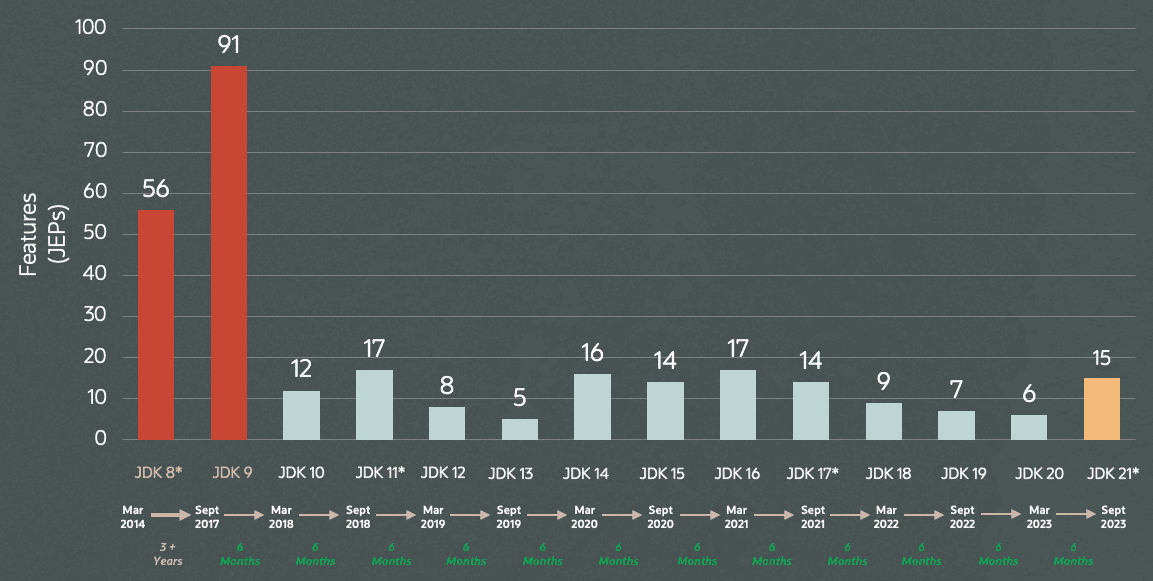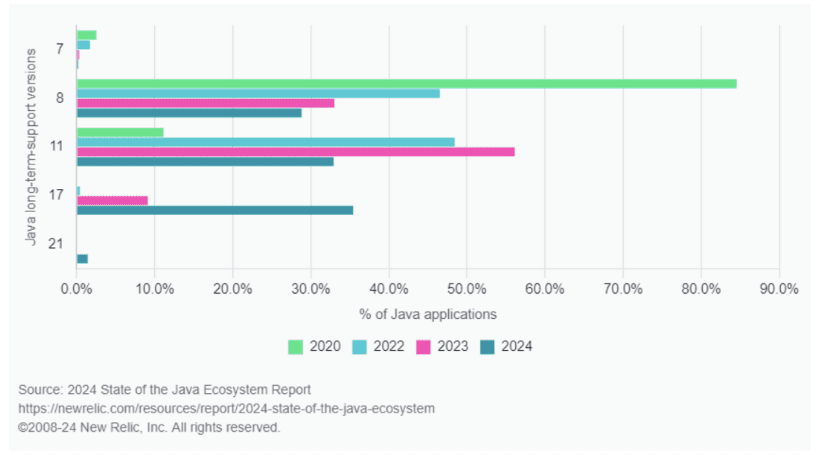Java is one of the most popular and influential programming languages in the world. Created in 1995 by Sun Microsystems, it quickly won the hearts of developers due to its simplicity, portability and reliability. Java has come a long way since version 1.0, gaining new features, improving performance, and expanding its scope. For more than twenty years, the Java SE platform and JDK have evolved in large, irregular, and somewhat unpredictable steps, according to Mark Reinhold, chief architect of the Java Platforms Group at Oracle. In 2017, updates for the Java language began to be released every six months. Now developers have the opportunity to access new features much more often than once every 2-3 of the year.

Oracle now releases a version in March and September that contains additional features and bug fixes, and a long-term support version every two years. It improves stability, security and performance. Java 21 was introduced in September 2023. It featured many innovations, including virtual threads, updated libraries, and syntax improvements. Despite frequent updates, many people continue to use old versions. But adoption of Java 21 is growing faster than previous versions: in the six months since its release, it was used in 1.4% of applications, while Java 17 was used by just 0.37%. Now Java 17 is already used by 35% of applications.

Java was originally designed with platform independence in mind. This became one of the main features of the language and contributed to its wide dissemination and popularity. The basis of this independence is the Java Virtual Machine (JVM), which runs bytecode compiled from Java source code. Thanks to this, Java applications can run on any platform where the JVM is installed, without the need to recompile the source code. Over time, these mechanisms have become more advanced and efficient. Java’s platform independence is a fundamental principle that makes it one of the most versatile programming languages in the world.
Over the years of language development, significant efforts have been made to optimize the compiler and virtual machine, which has significantly increased the efficiency of applications. By optimizing memory, threading, and parallelism, Java has become one of the most efficient programming languages for creating high-load and scalable applications.
Various versions of Java have introduced numerous tools and mechanisms to improve performance, such as support for parallel and asynchronous computing, memory and resource optimizations, as well as new algorithms and data structures. The platform gets better with each new release, from improving performance when updating the version, to taking advantage of the capabilities of modern hardware, and providing stable pause times when working with very large volumes of data. These changes allow developers to create faster, more efficient, and responsive applications, making the language even more attractive to a wider range of developers.
Java has always been focused on creating secure software solutions, and over the years, it has become one of the most secure programming languages. Over the past decades, the language has introduced many mechanisms and tools to ensure application security, such as access control systems, type checking, encryption, and data protection. These mechanisms allow developers to create reliable and secure applications for a variety of purposes. To ensure security, improved mechanisms for checking code integrity, protecting against attacks and vulnerabilities, as well as new tools for detecting and preventing threats were introduced. These changes make Java a safe and reliable programming language that can be used to create even mission-critical applications.
With the passage of time, the development of technology and the emergence of new requirements, the ease of use of Java remained one of the main priorities of developers. This includes not only simplicity of syntax and clarity of code structure, but also the availability of a wide range of tools and resources for developers. The stable development of the Java ecosystem, including development environments, frameworks, libraries and tools, provides a convenient working environment and increases developer productivity. Recent versions of Java have introduced new features and improvements to improve the usability of the language. This includes simplifying syntax, adding new APIs and libraries, and improving development tools. All these changes make Java more attractive and convenient for developers and contribute to its further development.
Java is not only a programming language, but also has a huge ecosystem of tools, libraries and frameworks that make the software development process much easier. This ecosystem develops in parallel with the language itself thanks to the active participation of developers. The role of the Java community cannot be overstated: according to a survey published on the website Statista, as of 2023, the size of the Java programming language community is 47.4% of software developers, making it the second most popular programming language in the world. The openness and activity of participants contribute to the development of new ideas, tools and standards. The Java Community Process plays an important role in this process, ensuring standardization and consistency of changes to the language and its ecosystem, which includes not only development tools, but also an extensive knowledge base, training resources and support, as well as events, conferences and developer meetings. All this contributes to the active exchange of experience and knowledge, which makes Java not just a programming language, but an entire socio-technical platform.
Sources:
Java version history, Wikipedia, (https://en.wikipedia.org)
There’s not a moment to lose!, Mark Reinhold (https://mreinhold.org)
Java Platform Evolution, Java (https://dev.java/evolution)
2024 State of the Java Ecosystem, New Relic (https://newrelic.com)


































